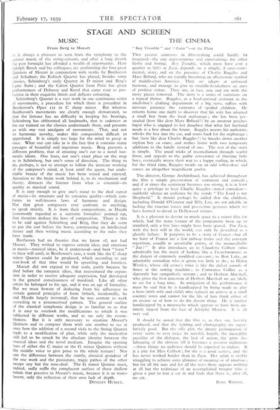STAGE AND SCREEN
From Berg to Mozart ,1 is always a pleasure to turn from the symphony to the quieter music of the string-consort, and after a long dearth the past fortnight has afforded a wealth of opportunity. Herr Adolph Busch and his colleagues are performing the four great Quintets of Mozart in conjunction with works by Beethoven and Schubert; the Kolisch Quartet has played, besides some classics, SchOnberg's early Quartet in D minor and Berg's Lyric Suite ; and the Calvet Quartet from Paris has given performances of Debussy and Ravel that came rear to per- fection in their exquisite finish and delicate colouring.
Schonberg's Quartet is a vast work in one continuous series of movements, a procedure for which there is precedent in Beethoven's Opus 131 in C sharp minor. But whereas Beethoven's movements are clearly enough demarcated, so that the listener has no difficulty in keeping his bearings, Schonberg has obliterated all landmarks, that is cadences as the ear trained on the classics understands them, and presents us with one vast amalgam of movements. That, and not its harmonic novelty, makes this composition difficult to apprehend. It is simply too large for the mind to grasp at once. What one can take in is the fact that it contains many passages of beautiful and ingenious music. Berg presents a different problem, that of attuning one's ear to a novel har- monic idiom. One loses, not one's exact place on the map as in Schonberg, but one's sense of direction. The thing to do, perhaps, is not to attempt to follow the intricate working of the composer's mind, at least until the queer, but unde- niable beauty of the music has been seized and enjoyed. Attention to the brain work behind it, to its mechanism and theory, distracts the listener from what is essential—its quality as musical sound.
It is easy enough to give one's mind to the dual aspect of music—its structure and its sensuous quality—which con- forms to well-known laws of harmony and design. Not that great composers ever conform to anything, to speak strictly. It is from their compositions, as Haydn (commonly regarded as a supreme formalist) pointed out, that theorists deduce the laws of composition. There is this to be said against Schonberg and Berg, that they do seem to put the cart before the horse, constructing an intellectual theory and then writing music according to the rules they have made.
Beethoven had no theories that we know of, nor had Mozart. They wished to express certain ideas and emotions in music—musical ideas, be it understood—and bent " form " to their will until, in Beethoven's case, a work like the C sharp minor Quartet could be produced, which according to any text-book of that time would be sprawling and formless.
Mozart did not expand to that scale, partly because he died before the romantic ideas, that necessitated the expan- sion in order to receive adequate expression, had developed in the general consciousness of mankind. Like all other artists he belonged to his age, and it was an age of formality. But we must beware of deducing from his adherence to certain general principles of form (which, incidentally, he and Haydn largely invented), that he was content to work according to a preconceived pattern. The general outline of the classical symphonic design is so familiar to us that it is easy to overlook the modifications to which it was subjected in different works, and to see only the resem- blances. But it is only necessary to examine Mozart's Quintets and to compare them with one another to see at once how the addition of a second viola to the String Quartet leads to a modification of plan, while only the insensitive will fail to be struck by the absolute identity between the musical ideas and the novel medium. Imagine the opening bars of either the C major or the G minor Quintets without the middle voice to give poise to the whole texture! Nor can the difference between the stately, classical grandeur of the one work and the passionate, tragic pathos of the other escape any but the tone-deaf. The G minor Quintet must, indeed, sadly ruffle the complacent surface of those shallow minds that perceive in Mozart's music, because it is so trans- lucent, only the reflection of their own lack of depth.
DY1s.'ELEY HUSSEY.










































 Previous page
Previous page